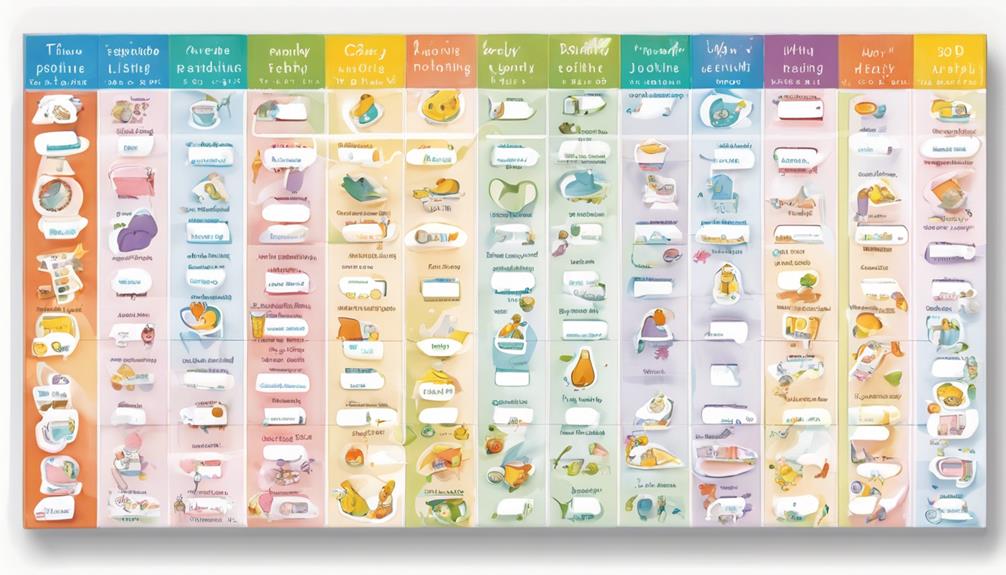By the time they are 1 month old, babies typically need to be fed every 2 to 4 hours, which adds up to about 6 to 8 feeding sessions per day. Creating a regular formula feeding schedule for your baby can make a big difference in establishing a routine that is beneficial for both the child and the caregiver.
Let's explore the intricacies of crafting a feeding schedule that suits your baby's needs and supports their growth and development in those important early weeks.
Key Takeaways
- Observe hunger cues and feed every 2-3 hours for a consistent routine.
- Gradually increase feeding amounts to match the 3-4 oz guideline per feeding.
- Monitor weight gain, diaper output, and baby's cues for nutritional adequacy.
- Implement paced feeding, maintain a quiet environment, and establish a bedtime routine for better feeding experiences.
Understanding Your Baby's Feeding Needs
Understanding a 1-month-old baby's feeding needs is important for promoting their best growth and development. At this tender age, babies typically consume 2-4 ounces of formula per feeding, with a daily intake ranging from 16-32 ounces spread over 8-12 feedings every 2-4 hours. It's essential to pay attention to hunger cues like rooting, hand-sucking, and increased alertness to establish a suitable feeding schedule that aligns with your baby's needs.
Additionally, burping your little one during and after feedings can help prevent discomfort and spit-up, ensuring smoother feeding sessions. Monitoring weight gain, diaper output, and overall contentment is essential in gauging if your baby is receiving adequate nutrition from the formula. By observing these indicators closely, you can make sure that your baby is thriving and receiving the nourishment needed for healthy development.
Establishing a Feeding Routine

To establish a consistent feeding routine for your 1-month-old baby, closely observe their hunger cues and respond promptly with appropriate formula feedings every 2-3 hours. At this age, babies typically consume around 2-4 oz of formula per feeding, but it's essential to monitor your baby's signals to determine when they're hungry. Keeping a record of feeding times and amounts can help you identify patterns, making it easier to adjust the schedule to fit your baby's needs.
Consistency is key in setting a predictable routine that benefits both your little one and you as a caregiver. If you have any concerns or questions about your baby's feeding schedule, don't hesitate to reach out to your pediatrician or a lactation consultant for personalized guidance on formula feeding your 1-month-old.
Recommended Feeding Amounts and Frequencies
Observing your 1-month-old's hunger cues plays a pivotal role in determining the recommended feeding amounts and frequencies for their best nutrition. At this age, infants typically consume about 2-4 oz of infant formula per feeding, with feedings occurring every 2-3 hours, totaling 8-12 feedings in a day. It's important to pay attention to your baby's signals of hunger to make sure they're adequately nourished. By watching for cues like rooting, sucking on fists, or becoming more alert, you can offer timely feedings that meet their needs.
To guarantee your little one is receiving sufficient nutrition, monitoring weight gain and growth is essential. If you have concerns about your baby's feeding habits or growth, consulting a pediatrician for personalized recommendations is highly encouraged. Your pediatrician can offer guidance tailored to your baby's specific needs and help you establish a feeding schedule that promotes the best health and development. Remember, every baby is unique, so seeking professional advice can provide invaluable support on your parenting journey.
Adapting the Schedule as Your Baby Grows

As your baby continues to grow, adjusting their feeding schedule to meet their evolving needs is important for ensuring the best nutrition and development. Here are some key points to take into account when changing your 1-4 month old baby's feeding schedule:
- Increase feeding amounts gradually to align with the recommended 3-4 oz per feeding guideline for this age range.
- Adjust the feeding schedule to accommodate longer stretches between feedings as your baby's stomach capacity increases.
- Monitor your baby's weight gain and feeding cues closely to determine if any further adjustments to the feeding schedule are necessary.
Tips for a Smooth Feeding Experience
For a smoother feeding experience, remember to utilize paced bottle feeding techniques to promote better digestion and mimic breastfeeding. By guaranteeing the feeding, you can help your baby regulate their intake, reducing the risk of overfeeding and digestive issues. Maintaining a quiet environment during feedings can minimize distractions, allowing your baby to focus on eating. Remember to burp your baby frequently, ideally after every 1-2 ounces of formula, to prevent discomfort from gas build-up.
Monitoring your baby's feeding patterns and preferences is essential to safeguard they're getting the nourishment they need. Keep track of feeding times, amounts consumed, and any reactions to formula. Additionally, introducing a consistent bedtime routine after the last feeding can signal to your baby that it's time for sleep, potentially leading to longer stretches of rest. By incorporating these tips into your feeding schedule, you can create a more enjoyable and effective feeding experience for both you and your baby.
Frequently Asked Questions
What Is the Feeding Schedule for a 1 Month Old Formula?
We guarantee your 1-month-old formula-fed baby thrives on 2-4 oz of formula every 2-3 hours. Pay attention to hunger cues, offering 6-8 feedings in 24 hours for growth. Consistent schedules promote healthy weight gain.
What Is a Good Schedule for a 1 Month Old?
Feeding a 1-month-old involves attentive observation for hunger cues like rooting or hand-sucking. We aim to meet their needs every 2-3 hours, encouraging 8-12 feedings a day. Building a bedtime routine can promote longer stretches of sleep at night.
What Is the Feeding Pattern for a 1 Month Old?
We feed our 1-month-old baby every 2-4 hours, offering 2-4 oz of formula per feeding. Following hunger cues is crucial. We aim for 6-8 feedings daily to support healthy growth. Monitoring weight gain guides us to adjust the feeding pattern as needed.
How Do I Make a Feeding Schedule for My Baby?
When making a feeding schedule for your baby, we focus on their weight, age, and hunger cues. Offering 3-4 oz of formula every 2-4 hours in 6-8 feedings daily meets their needs. Adjust based on cues and behavior for a happy, well-fed baby.
Conclusion
In summary, creating a 1-month-old formula feeding schedule is vital for your baby's growth and development. By following a structured routine, you can guarantee that your baby is getting the right amount of nutrition at the right times.
Remember, every baby is unique, so don't hesitate to adjust the schedule as needed. Are you ready to give your little one the best start in life with a well-planned feeding schedule?









